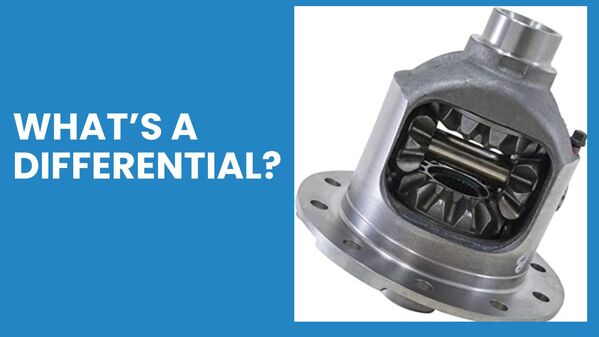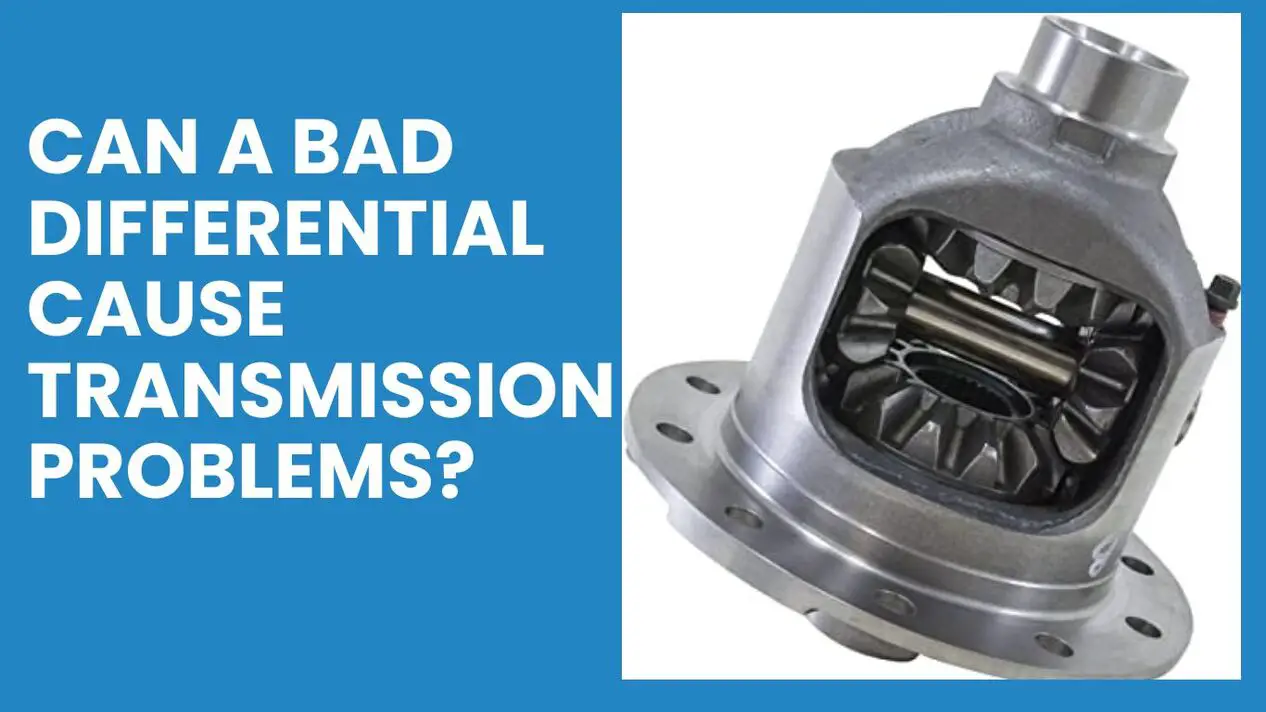Are you having unexplained transmission problems in your vehicle? If so, it could be the result of a faulty differential.
A bad differential can result in transmission problems. The differential is a component of the drivetrain that permits the wheels to rotate at varying speeds while still providing power to both wheels. If the differential is damaged or worn out, it can result in a variety of problems that impact the transmission and other drivetrain components.
The article will go over the symptoms of a bad differential and the solutions available for fixing it. Come on, then, and we’ll start right away!
Read also:
- Causes of Rear Differential Failure with Troubleshooting Direction
- Can A Bad Differential Cause Power Loss: An In-Depth Analysis
What’s A Differential?

A differential is a gearbox located between a vehicle’s wheels. It allows wheels to rotate at different speeds during turns. This difference in rotation is crucial for smooth turning. Without a differential, tires would wear unevenly and quickly.
Differentials vary based on the drive type of vehicle. For front-wheel drive, it’s integrated into the transmission. Rear-wheel-drive vehicles have it between the rear wheels. All-wheel-drive systems have differentials on both axles and between them.
The main types of differentials are open, limited-slip, and locking. Open differentials are standard in most vehicles. They distribute power evenly but have limitations in low traction. Limited-slip differentials overcome these limitations by redirecting torque to the wheel with more grip. Locking differentials, used in off-road vehicles, lock the rotation of both wheels together for maximum traction.
In performance cars, the differential can be adjusted for handling characteristics. This tuning changes how the car handles on roads or tracks. Regular maintenance of the differential is crucial. It involves checking and changing the differential oil.
Differential oil lubricates the gears and bearings inside. Over time, this oil can break down. When this happens, the differential becomes noisy and less efficient. Ignoring these signs can lead to costly repairs. Differential failure affects vehicle handling and safety.
The differential is a key component in a vehicle. It balances the difference in wheel rotation during turns. Its maintenance is vital for vehicle performance and safety.
What Are The Symptoms Of A Bad Differential?
Symptoms of a bad differential include:
Unusual Noises: Whining, howling, or clunking sounds, especially during turns or changes in speed.
Vibrations: Noticeable shaking or rumbling from the vehicle, indicating worn bearings or gears.
Difficulty in Handling: Challenges in steering or vehicle pulling to one side, reflecting uneven power distribution to the wheels.
Gear Grinding: Sensation of gears grinding, indicating severe internal wear.
Fluid Leaks: Leaking differential fluid, essential for lubrication and cooling.
Poor Acceleration: Decline in vehicle’s acceleration and performance.
Increased Tire Wear: Abnormal wear patterns on tires due to improper wheel rotation.
Excessive Heat: Overheating around the differential area, a sign of friction and wear inside.
How Can A Bad Differential Affect The Transmission?
Different transmission issues can arise as a result of a poor differential. These problems could be anything from making it challenging to shift gears to experiencing driveline vibration or total gear failure.
The differential is an essential component of the powertrain, transferring engine torque to the drive wheel axles and enabling them to turn at various speeds when going around corners.
Your car’s transmission may experience serious issues when the differential isn’t functioning correctly, necessitating expensive repairs or replacements.
The transmission and differential are typically housed in the same housing and use the same lubricant in front-wheel drive vehicles.
Due to the metal dust that is dispersed throughout the container, if one of them malfunctions, it might affect the other as well.
Here are some causes of transmission issues that a poor differential could lead to:
Poor Acceleration and Shifting:
A broken differential can lead to problems with changing and poor acceleration. When the differential is malfunctioning, the gearbox may have to work harder to make up for the loss of power sent to the wheels. This may cause the transmission to have trouble correctly shifting, resulting in jerky movements and subpar acceleration.
Whining sound:
When the car is moving, a faulty differential can make a whining sound that can be heard. The differential’s worn-out gears are the source of this noise, which can also harm the transmission through vibration and friction.
Transmission Overheating:
A broken differential may be to blame. The wheels may spin at various speeds when the differential malfunctions, which can strain the transmission. This can cause the transmission fluid to heat up and possibly cause damage to the transmission.
Slipping Gearbox:
A poor differential can make the transmission slip. The gearbox may slip when the differential is not properly transferring power to the wheels, which will result in a loss of power and acceleration.
What are the signs of Transmission Problems?
You must learn the factors that will indicate your transmission has some problems. You should be aware of these warnings to anticipate a problem with your transmission. Okay, now the next question is, what are they?
Delayed or erratic shifting:
Transmission problems can manifest as delayed gear changes or jerky transitions between speeds. As an additional symptom, you may experience a jerking feeling whenever you make a movement.
Disturbing noises:
Grinding, whining, or clunking noises are all possible symptoms of a failing gearbox.
The Smell of Burning:
If you detect a burning smell coming from your vehicle’s transmission, it may indicate a severe problem. Overheating or a loss of transmission oil could be to blame.
Transmission slipping:
When the transmission slips, the engine revs higher than normal, but the car doesn’t accelerate as fast as it should because the transmission isn’t fully engaged.
Leaking transmission fluid:
If you see a pool of red fluid under your car, it may be transmission oil leaking.
Warning light:
If your dashboard’s “Check Engine” or “Transmission” caution light comes on, this could be an indication of a problem with your vehicle’s transmission.
All of these symptoms require immediate attention from a professional technician. If you neglect these warning signs, you may end up with a much more costly transmission repair bill.
What Options Do You Have for Fixing a Broken Differential?
1. Clean and protect it from road grime as often as possible because dirt and other debris can easily cause the system to break or fail completely if left alone.
2. Professional mechanics fix issues with the differential by figuring out what is wrong. The differential oil can be changed to fix most problems. This gear oil makes sure that the axle bearings, pinion gears, and ring gear work well.
3. If there is too much harm to fix, you may need to replace the whole differential. It’s important to get your car checked out regularly and fix any problems with the drive train before they lead to expensive fixes or damage to other parts of your car.
By taking the right steps and fixing problems with the differential as soon as you notice them, you can keep transmission problems from happening and make sure your car is running at its best.
So, don’t ignore any signs of a bad difference. Take care of them right away, and stay safe on the road.
Conclusion
A bad differential can cause transmission problems in your vehicle. If you think something is wrong with how your car moves, you should always have a professional check it out as soon as possible. Once you’ve found the problem and figured out what needs to be done, you should take care of it right away to stop any more damage from happening. By taking care of your car now, you can make sure it stays in good shape for years to come.
